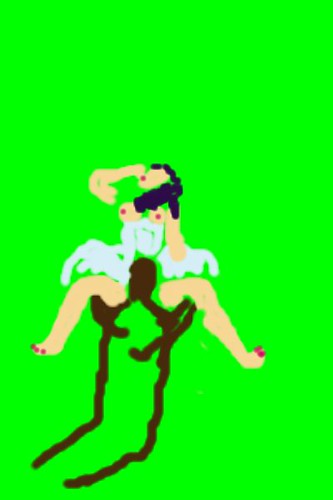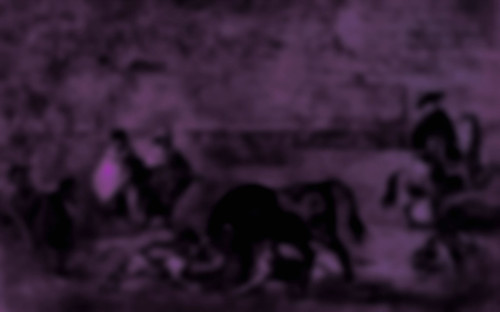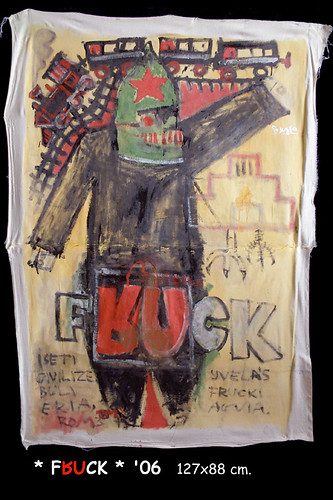 |
| From Drop Box |
The best Blog on Art from the Caucasus, contributed and read worldwide + der Schützenpanzer unter den Kunstblogs + + Visuals Virtual Reality Caucasus Style + Net + Tbilisi and beyond
Sunday, November 30, 2008
out of touch by sandy farazjou
traces everywhere,
don’t you dare forget,
forget the image behind my eyes
I touch,
touching gently the paper,
the paper you wrote your name on
I touch,
touching softly the hat,
the hat I was wearing
I try,
try to touch you through all but you,
untouchable as you are – now.
now it’s your handwriting, my hat,
your handwriting, my hat, your handwriting,
my hat, handwriting, hat,
handwriting, hat, handwriting
I touch you, through all, but you
don’t you dare forget,
forget the image behind my eyes
I touch,
touching gently the paper,
the paper you wrote your name on
I touch,
touching softly the hat,
the hat I was wearing
I try,
try to touch you through all but you,
untouchable as you are – now.
now it’s your handwriting, my hat,
your handwriting, my hat, your handwriting,
my hat, handwriting, hat,
handwriting, hat, handwriting
I touch you, through all, but you
Labels:
poetry
Film Crew in Rustavi
 |
| From Drop Box |
Next time more!
Labels:
Art,
Art on Video,
film
Saturday, November 29, 2008
Thursday, November 27, 2008
for flickr war
my finished collage. i am now working on some new sketches to make more finished pieces.
Wednesday, November 26, 2008
I really, really
I really recommend this article (print it out) about the Middlebrow issue of todays art:
Tuesday, November 25, 2008
Green Queen Golden Mask by Ivan Pope
 |
| From Drop Box |
2004, mixed media on print
Original here
http://blog.ivanpope.com/awol/2008/11/green-queen-gol.html
Monday, November 24, 2008
ArtTivi, NewArtTV
Get some latest trends from the International Art World:
Thanks to Martin Bromirski and Anaba, one of the coolest Art Blogs around
and last but not least, the 12 seconds video format is also nice:
http://12seconds.tv/channel/grijsz
Labels:
Art on Video,
TV
Sunday, November 23, 2008
Joseph Beuys' music on Ubuweb
http://www.ubu.com/sound/beuys.html
What is a great surprize, thank you Caucasus Online !, 47 MB can now be downloaded in ~ 3 minutes ! Thanks, the pain last weeks with the connection was worth the improvement !
Labels:
Joseph Beuys,
music,
other artists,
sound
bht01
by dropcraft, amazing artist from London
http://www.flickr.com/photos/26163660@N05/
Labels:
British Art,
dropcraft,
England,
painting contemporary,
UK
Saturday, November 22, 2008
Friday, November 21, 2008
Thursday, November 20, 2008
Bessa says: F-RU-CK
Bessa Kartlelishvili is a long time member already, but got his link only today: He works as a painter and muralist and his websites are:
http://boheme.ge/
Labels:
Bessa,
Kartlelishvili,
member
Wednesday, November 19, 2008
INFO: Art groups in the 1990s and 2000s in Eastern Europe
Touring exhibition OVERcoming DICTatorships (CULTURE 2000), organized by the Chair in European Studies of Dresden Technical University (lead partner) in collaboration with the University of Ústi nad Labem, Andrzej Frycz Modrzewski Krakow University College, Open Society Archives Budapest, Institute for the Investigation of Communist Crimes in Romania in Bucharest, University of Trento, University of Birmingham.
Next station: Gallery U Frycza at the Andrzej Frycz Modrzewski Krakow
University College. Opening: 24 November 2008, 12:00.
How do artists who experienced the challenging changes relate to the year 1989 and the then forced or enabled ideological migration caused by collective political-economic upheavals? How do they respond visually to their own specific ‘locations’? During the conference “Roles of the visual in overcoming dictatorships” (CRN fund of the University of Birmingham) and the celebratory opening of the exhibition these questions were examined at the Barber Institute of
Fine Arts at the University of Birmingham on 8-9 October 2008.
The full report which documents the conference and opening speeches of Rt. Hon. Neil Kinnock (London), project leader Prof. Dr. Dr. Gerhard Besier (Dresden) and exhibition convener Dr. Dr. Jutta Vinzent (Birmingham) is now available on
http://lehrstuhl-europastudien.eu/eu/b06_2-2.pdf .
See http://overcomings.blogspot.com for the video documentation of the project and selected interviews. Featured artist in November 2008: Harald Hauswald (Berlin).
The exhibition was preceded by a Round-Table discussion at the renowned Birmingham Ikon Gallery on 8 November. Chaired by curator Nigel Prince project artists Harald Hauswald (Berlin), Vlad Nancă (Bucharest), Sándor Pinczehelyi (Pécs) and Silvestro Lodi (Venice) presented their personal reflections on the topic to Ikon’s lively audience. Nancă started with putting his two contributions to the exhibition – the installations “I do not know what union I belong to anymore” (2003) and “Ideal” (2007) – into context. His attention is taken by state symbols and how they relate to mentalities and the political practice of a given political
entity. While his sardonic swapping (Erden Kosova) of colours and symbols of the flags of the Soviet Union and the European Union provoked rather harsh moral criticism in the past, he managed to give his recent work combining the flags of communist Hungary, East Germany and Romania a much stronger personal and empathetic note.
“For a few days” in 1989, the artist pointed out, “in each of these countries the national flag was not only without an emblem but with a hole in the middle. To me this is a symbol of pure freedom, something that could only happen in times of such strong spiritual engagement and idealistic vows.” In “Ideal” Nancă put the three flags together in a row in order to construct a spiritual union which encompasses time, history and borders. What combines them is the removal of the symbols used to distinguish, not to unite. The artistic intervention (re-)creates “a spiritual union of genuine revolutionary freedom, where no symbols are spoiling the essence of those days of liberty. It is an Ideal union I wish I could belong to.”
Symbols of political rule also played a pivotal role in Sándor Pinczehelyi’s early 1970s works, in which he had tried to create a genuine Eastern European style. Using hammer and sickle was a means to reveal the isolation from the world and the feeling of a crucifixion, of being forgotten and left behind. The artist wanted to “offload the ideological burden that these objects had collected and then to reinstate them in their fundamental role.” Confronting his former oeuvre throughout the 1990s and 2000s, Pinczehelyi did not simply intend to excavate a past in danger of oblivion but to inter- relate past and present. His works are not only a witness account of
changing structures and values; he touches upon the empty space that is the present. Symbols have not been reinstated; they have lost their meaning. For Pinczehelyi who never saw himself as a “political artist” but touched upon the political that determined his social environment this situation has a far-reaching implication for artistic credibility and responsibility. He aims at “holding up a faithful mirror to the spectator.”
The Brandenburg Gate in Berlin is a magic point in Harald Hauswald’s life and artistic endeavours. The central pair of his photographic contribution is formed by contrasting two snapshots from the early and late 1980s, one depicting the yearning of Easterners craving for
entry to the West, the other the unforeseen day of their admittance in 1989: “People ran out into the world. The earth turned into the globe again.” For Hauswald, who was a great fan of rock music and enriched his photographic skills and archive while exploring Berlin as a telegram messenger, the historical opening of the Brandenburg Gate was an existential experience of freedom. His doings and whereabouts were no longer classified as political and he was finally able to follow his own initiatives. Political topics slowly vanished from his work and his approach to photography changed a lot: “it moved from my mind to my guts.” Where the state as the eternal opponent disappeared, people became visible. Hauswald depicts human
beings as artworks and studies their encounters in public space. Yet his personal appreciation of the transition process reiterates a feeling of emptiness, although in colours different from Nancă’s or Pinczehelyi’s: “What were emotions then are sentiments today.”
Silvestro Lodi, the only Western-born participant at the Round Table, provided the capstone of the East-Western artistic bridge erected during this evening. Fascinated by the procedures, metrics and taxonomies of different professions Lodi dedicates his work to regenerating human actions in the negatives of an ideal-model template. He has been convening them in an encyclopaedic inventory for several years already. Although this practice alone would have
offered intriguing material for discussion, the artist preferred not to present his contribution but his workplace, the city of Venice, to the audience. Following Lodi, who teaches at the Università Ca’ Foscari di Venezia and the Studio Tredici Scuola di Pittura, in Venice there is no hope and no art system at all. Venice is a secluded and touristy “showcase” city devoid of refreshing interfaces with its industrially productive periphery Mestre, which is a
cultural wasteland. Art is neither created nor produced in a process of social exchange any more, but sold on a market. Figuring as market participants and entrepreneurs artists are subject to an economy of rapid interest which defies any standards of intellectual development. “We artists looked at ourselves after years of solipsism. We are now trying to talk to each other, in the hope that the sounds of our voices will reach the ears and brains of our street
companions – critics and art historians.” When Lodi emphatically called for the establishment of new “crossroads” between structures and individuals, he reintroduced a historic concept to our present that in his eyes carries much stronger weight than the memory of all recent dictatorships: “We are in need of a new Renaissance.”
Next station: Gallery U Frycza at the Andrzej Frycz Modrzewski Krakow
University College. Opening: 24 November 2008, 12:00.
How do artists who experienced the challenging changes relate to the year 1989 and the then forced or enabled ideological migration caused by collective political-economic upheavals? How do they respond visually to their own specific ‘locations’? During the conference “Roles of the visual in overcoming dictatorships” (CRN fund of the University of Birmingham) and the celebratory opening of the exhibition these questions were examined at the Barber Institute of
Fine Arts at the University of Birmingham on 8-9 October 2008.
The full report which documents the conference and opening speeches of Rt. Hon. Neil Kinnock (London), project leader Prof. Dr. Dr. Gerhard Besier (Dresden) and exhibition convener Dr. Dr. Jutta Vinzent (Birmingham) is now available on
http://lehrstuhl-
See http://overcomings.blogspot.
The exhibition was preceded by a Round-Table discussion at the renowned Birmingham Ikon Gallery on 8 November. Chaired by curator Nigel Prince project artists Harald Hauswald (Berlin), Vlad Nancă (Bucharest), Sándor Pinczehelyi (Pécs) and Silvestro Lodi (Venice) presented their personal reflections on the topic to Ikon’s lively audience. Nancă started with putting his two contributions to the exhibition – the installations “I do not know what union I belong to anymore” (2003) and “Ideal” (2007) – into context. His attention is taken by state symbols and how they relate to mentalities and the political practice of a given political
entity. While his sardonic swapping (Erden Kosova) of colours and symbols of the flags of the Soviet Union and the European Union provoked rather harsh moral criticism in the past, he managed to give his recent work combining the flags of communist Hungary, East Germany and Romania a much stronger personal and empathetic note.
“For a few days” in 1989, the artist pointed out, “in each of these countries the national flag was not only without an emblem but with a hole in the middle. To me this is a symbol of pure freedom, something that could only happen in times of such strong spiritual engagement and idealistic vows.” In “Ideal” Nancă put the three flags together in a row in order to construct a spiritual union which encompasses time, history and borders. What combines them is the removal of the symbols used to distinguish, not to unite. The artistic intervention (re-)creates “a spiritual union of genuine revolutionary freedom, where no symbols are spoiling the essence of those days of liberty. It is an Ideal union I wish I could belong to.”
Symbols of political rule also played a pivotal role in Sándor Pinczehelyi’s early 1970s works, in which he had tried to create a genuine Eastern European style. Using hammer and sickle was a means to reveal the isolation from the world and the feeling of a crucifixion, of being forgotten and left behind. The artist wanted to “offload the ideological burden that these objects had collected and then to reinstate them in their fundamental role.” Confronting his former oeuvre throughout the 1990s and 2000s, Pinczehelyi did not simply intend to excavate a past in danger of oblivion but to inter- relate past and present. His works are not only a witness account of
changing structures and values; he touches upon the empty space that is the present. Symbols have not been reinstated; they have lost their meaning. For Pinczehelyi who never saw himself as a “political artist” but touched upon the political that determined his social environment this situation has a far-reaching implication for artistic credibility and responsibility. He aims at “holding up a faithful mirror to the spectator.”
The Brandenburg Gate in Berlin is a magic point in Harald Hauswald’s life and artistic endeavours. The central pair of his photographic contribution is formed by contrasting two snapshots from the early and late 1980s, one depicting the yearning of Easterners craving for
entry to the West, the other the unforeseen day of their admittance in 1989: “People ran out into the world. The earth turned into the globe again.” For Hauswald, who was a great fan of rock music and enriched his photographic skills and archive while exploring Berlin as a telegram messenger, the historical opening of the Brandenburg Gate was an existential experience of freedom. His doings and whereabouts were no longer classified as political and he was finally able to follow his own initiatives. Political topics slowly vanished from his work and his approach to photography changed a lot: “it moved from my mind to my guts.” Where the state as the eternal opponent disappeared, people became visible. Hauswald depicts human
beings as artworks and studies their encounters in public space. Yet his personal appreciation of the transition process reiterates a feeling of emptiness, although in colours different from Nancă’s or Pinczehelyi’s: “What were emotions then are sentiments today.”
Silvestro Lodi, the only Western-born participant at the Round Table, provided the capstone of the East-Western artistic bridge erected during this evening. Fascinated by the procedures, metrics and taxonomies of different professions Lodi dedicates his work to regenerating human actions in the negatives of an ideal-model template. He has been convening them in an encyclopaedic inventory for several years already. Although this practice alone would have
offered intriguing material for discussion, the artist preferred not to present his contribution but his workplace, the city of Venice, to the audience. Following Lodi, who teaches at the Università Ca’ Foscari di Venezia and the Studio Tredici Scuola di Pittura, in Venice there is no hope and no art system at all. Venice is a secluded and touristy “showcase” city devoid of refreshing interfaces with its industrially productive periphery Mestre, which is a
cultural wasteland. Art is neither created nor produced in a process of social exchange any more, but sold on a market. Figuring as market participants and entrepreneurs artists are subject to an economy of rapid interest which defies any standards of intellectual development. “We artists looked at ourselves after years of solipsism. We are now trying to talk to each other, in the hope that the sounds of our voices will reach the ears and brains of our street
companions – critics and art historians.” When Lodi emphatically called for the establishment of new “crossroads” between structures and individuals, he reintroduced a historic concept to our present that in his eyes carries much stronger weight than the memory of all recent dictatorships: “We are in need of a new Renaissance.”
Labels:
Art Eurasia
Tuesday, November 18, 2008
Mayakovsky, Rosta Window
Labels:
Majakowski,
Mayakovsky,
Rosta
Artists from Stockholm 1



Jockum Nordström 1963
Nordström was considered as one of the most exciting and intriguing artists of his generation in Stockholm. Here you can see some of his works http://www.artnet.com/artist/423818800/jockum-nordstrom.html
Konzentration+Explosion+John
 |
| From Drop Box |
more here at Holger John Studio
http://holger-john.blogspot.com/2008/11/konzentration-john.html
Labels:
Black White,
Drawings,
Holger John
Nice Flash-Animation-Presentation of Carsten Nicolai's "Anti Reflex"
http://www.antireflex.de/exhibition.htm
(Please allow your browser POP-UP-Windows)
I guess this Animation was expensive, I adore it, very cool elements.
Labels:
animation,
Anti Reflex,
Carsten Nicolai,
Flash
Monday, November 17, 2008
Subscribe to:
Comments (Atom)



























































